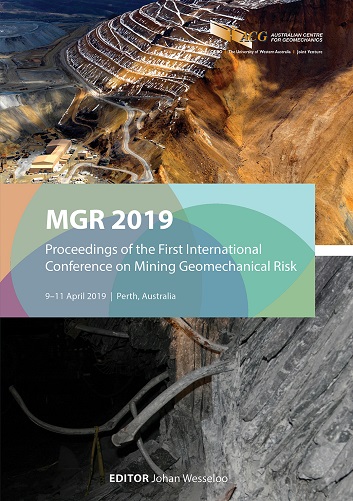The role of the geotechnical model for rapid integration in managing operational geotechnical risk

|
Authors: Brockman, MC; Gosche, KMR; Du Plooy, DJ |
DOI https://doi.org/10.36487/ACG_rep/1905_24_Brockman
Cite As:
Brockman, MC, Gosche, KMR & Du Plooy, DJ 2019, 'The role of the geotechnical model for rapid integration in managing operational geotechnical risk', in J Wesseloo (ed.), MGR 2019: Proceedings of the First International Conference on Mining Geomechanical Risk, Australian Centre for Geomechanics, Perth, pp. 403-418, https://doi.org/10.36487/ACG_rep/1905_24_Brockman
Abstract:
AngloGold Ashanti (AGA) has developed a concept to integrate geotechnical input into long-term mine planning using a ‘block model approach’ referred to as a geotechnical model for rapid integration (GMRi). The GMRi is a simple spatial collection of rock mass data integrated with empirical evaluations, numerical modelling results and monitoring data for a specific mine plan. In this paper, the value of using the GMRi to manage geotechnical risk and identify opportunities associated with ground support design, stress-induced damage, design stope spans and total extraction is demonstrated. The GMRi concept allows for the rapid evaluation of spatially distributed geotechnical data and identifies areas of risk and opportunity, demonstrated at two recent underground studies completed at AGA’s Australian operations.
Keywords: rock mass model, geotechnical block model, GMRi, geotechnical risk management
References:
Barton, N, Lien, R, & Lunde, J 1974, ‘Engineering classification of rock masses for the design of tunnel support’, Rock Mechanics and Rock Engineering, vol. 6, issue 4, pp. 189–236.
Basson, FRP 2018, GEM4D Software, version 1.8.0.1, computer software, BasRock, Perth, www.basrock.net/gem4d
Brockman, M 2014, The Application of the Modified Stability Graph Method for a Massive Rock Mass in a Low Stress Environment, masters thesis, Curtin University, Perth.
Jager, A & Ryder, J 1999, A Handbook on Rock Engineering Practice for Tabular Hard Rock Mines, SIMRAC, Johannesburg.
Lunder, J 1994, Hard Rock Pillar Strength Estimation an Applied Emprical Approach, MASc thesis, The University of British Columbia, Vancouver.
Mathews, K, Hoek, E, Wylie, D, & Stewart, S 1981, Prediction of stable excavations for mining at depth below 1,000 metres in hard rock, CANMET Library & Documentation Services Division, Ottowa.
Nickson, S 1992, Cable Support Guidelines for Underground Hard Rock Mine Operations, masters thesis, The University of British Columbia, Vancouver.
Potvin, Y 1988, Empirical Open Stope Design in Canada, PhD thesis, University of British Colombia, Vancouver.
Potvin, Y & Hadjigeorgiou, J 2016, ‘Selection of ground supoort for mining drives based on the Q-system’, in E Nordlund, T Jones & A Eitzenberger (eds), Proceedings of the 8th International Symposium on Ground Support in Mining and Underground Construction, Luleå University of Technology, Luleå, pp. 1–16.
Sandy, M, Sharrock, G, Albrecht, J & Vakili, A 2010, ‘Managing the transition from low stress to high stress conditions’, Proceedings of the Second Australasian Ground Control in Mining Conference, The Australian Institute of Mining and Metallurgy, Melbourne.
Seequent 2018, Leapfrog Geo, version 4.1, computer software, Seequent, Addington, www.leapfrog3d.com
Wieben, K 2016, CYLP 2016 SDGM Project, unpublished internal AngloGold Ashanti report.
Wiles, T 2018, Map3D, version 67, computer software, Map3D, https://map3d.com/index
Wiles, T 2007, ‘Evidence based model calibration for reliable predictions’, Proceedings of the Fourth International Seminar on Deep and High Stress Mining, Australian Centre of Geomechanics, Perth, pp. 3–20.
© Copyright 2025, Australian Centre for Geomechanics (ACG), The University of Western Australia. All rights reserved.
View copyright/legal information
Please direct any queries or error reports to repository-acg@uwa.edu.au
View copyright/legal information
Please direct any queries or error reports to repository-acg@uwa.edu.au
